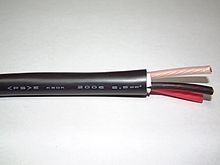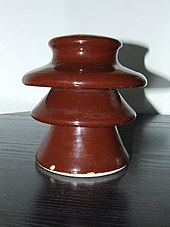Insulator (electricity)
Jump to navigationJump to search
| Part of a series of articles about |
| Electromagnetism |
|---|
 |
An electrical insulator is a material in which the electron does not flow freely or the atom of the insulator have tightly bound electrons whose internal electric charges do not flow freely; very little electric current will flow through it under the influence of an electric field. This contrasts with other materials, semiconductors and conductors, which conduct electric current more easily. The property that distinguishes an insulator is its resistivity; insulators have higher resistivity than semiconductors or conductors. The most common examples are non-metals.
A perfect insulator does not exist because even insulators contain small numbers of mobile charges (charge carriers) which can carry current. In addition, all insulators become electrically conductive when a sufficiently large voltage is applied that the electric field tears electrons away from the atoms. This is known as the breakdown voltage of an insulator. Some materials such as glass, paper and Teflon, which have high resistivity, are very good electrical insulators. A much larger class of materials, even though they may have lower bulk resistivity, are still good enough to prevent significant current from flowing at normally used voltages, and thus are employed as insulation for electrical wiring and cables. Examples include rubber-like polymers and most plastics which can be thermoset or thermoplastic in nature.
Insulators are used in electrical equipment to support and separate electrical conductors without allowing current through themselves. An insulating material used in bulk to wrap electrical cables or other equipment is called insulation. The term insulator is also used more specifically to refer to insulating supports used to attach electric power distribution or transmission lines to utility poles and transmission towers. They support the weight of the suspended wires without allowing the current to flow through the tower to ground.
Physics of conduction in solids[edit]
Electrical insulation is the absence of electrical conduction. Electronic band theory (a branch of physics) dictates that a charge flows if states are available into which electrons can be excited. This allows electrons to gain energy and thereby move through a conductor such as a metal. If no such states are available, the material is an insulator.
Most (though not all, see Mott insulator) insulators have a large band gap. This occurs because the “valence” band containing the highest energy electrons is full, and a large energy gap separates this band from the next band above it. There is always some voltage (called the breakdown voltage) that gives electrons enough energy to be excited into this band. Once this voltage is exceeded the material ceases being an insulator, and charge begins to pass through it. However, it is usually accompanied by physical or chemical changes that permanently degrade the material’s insulating properties.
Materials that lack electron conduction are insulators if they lack other mobile charges as well. For example, if a liquid or gas contains ions, then the ions can be made to flow as an electric current, and the material is a conductor. Electrolytes and plasmas contain ions and act as conductors whether or not electron flow is involved.
Breakdown[edit]
When subjected to a high enough voltage, insulators suffer from the phenomenon of electrical breakdown. When the electric field applied across an insulating substance exceeds in any location the threshold breakdown field for that substance, the insulator suddenly becomes a conductor, causing a large increase in current, an electric arc through the substance. Electrical breakdown occurs when the electric field in the material is strong enough to accelerate free charge carriers (electrons and ions, which are always present at low concentrations) to a high enough velocity to knock electrons from atoms when they strike them, ionizing the atoms. These freed electrons and ions are in turn accelerated and strike other atoms, creating more charge carriers, in a chain reaction. Rapidly the insulator becomes filled with mobile charge carriers, and its resistance drops to a low level. In a solid, the breakdown voltage is proportional to the band gap energy. When corona discharge occurs, the air in a region around a high-voltage conductor can break down and ionise without a catastrophic increase in current. However, if the region of air breakdown extends to another conductor at a different voltage it creates a conductive path between them, and a large current flows through the air, creating an electric arc. Even a vacuum can suffer a sort of breakdown, but in this case the breakdown or vacuum arc involves charges ejected from the surface of metal electrodes rather than produced by the vacuum itself.
In addition, all insulators become conductors at very high temperatures as the thermal energy of the valence electrons is sufficient to put them in the conduction band.[1][2]
In certain capacitors, shorts between electrodes formed due to dielectric breakdown can disappear when the applied electric field is reduced.[3][4][5][relevant? ]
Uses[edit]
A very flexible coating of an insulator is often applied to electric wire and cable, this is called insulated wire. Wires sometimes don’t use an insulating coating, just air, since a solid (e.g. plastic) coating may be impractical. However, wires that touch each other produce cross connections, short circuits, and fire hazards. In coaxial cable the center conductor must be supported exactly in the middle of the hollow shield to prevent EM wave reflections. Finally, wires that expose voltages higher than 60 V[citation needed] can cause human shock and electrocution hazards. Insulating coatings help to prevent all of these problems.
Some wires have a mechanical covering with no voltage rating[citation needed]—e.g.: service-drop, welding, doorbell, thermostat wire. An insulated wire or cable has a voltage rating and a maximum conductor temperature rating. It may not have an ampacity (current-carrying capacity) rating, since this is dependent upon the surrounding environment (e.g. ambient temperature).
In electronic systems, printed circuit boards are made from epoxy plastic and fibreglass. The nonconductive boards support layers of copper foil conductors. In electronic devices, the tiny and delicate active components are embedded within nonconductive epoxy or phenolic plastics, or within baked glass or ceramic coatings.
In microelectronic components such as transistors and ICs, the silicon material is normally a conductor because of doping, but it can easily be selectively transformed into a good insulator by the application of heat and oxygen. Oxidised silicon is quartz, i.e. silicon dioxide, the primary component of glass.
In high voltage systems containing transformers and capacitors, liquid insulator oil is the typical method used for preventing arcs. The oil replaces air in spaces that must support significant voltage without electrical breakdown. Other high voltage system insulation materials include ceramic or glass wire holders, gas, vacuum, and simply placing wires far enough apart to use air as insulation.
Telegraph and power transmission insulators[edit]
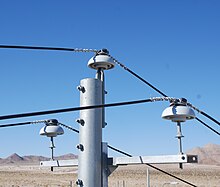
Power lines supported by ceramic pin-type insulators in California, USA
Overhead conductors for high-voltage electric power transmission are bare, and are insulated by the surrounding air. Conductors for lower voltages in distribution may have some insulation but are often bare as well. Insulating supports called insulators are required at the points where they are supported by utility poles or transmission towers. Insulators are also required where the wire enters buildings or electrical devices, such as transformers or circuit breakers, to insulate the wire from the case. These hollow insulators with a conductor inside them are called bushings.
Material[edit]
Insulators used for high-voltage power transmission are made from glass, porcelain or composite polymer materials. Porcelain insulators are made from clay, quartz or alumina and feldspar, and are covered with a smooth glaze to shed water. Insulators made from porcelain rich in alumina are used where high mechanical strength is a criterion. Porcelain has a dielectric strength of about 4–10 kV/mm.[6] Glass has a higher dielectric strength, but it attracts condensation and the thick irregular shapes needed for insulators are difficult to cast without internal strains.[7] Some insulator manufacturers stopped making glass insulators in the late 1960s, switching to ceramic materials.
Recently, some electric utilities have begun converting to polymer composite materials for some types of insulators. These are typically composed of a central rod made of fibre reinforced plastic and an outer weathershed made of silicone rubber or ethylene propylene diene monomer rubber (EPDM). Composite insulators are less costly, lighter in weight, and have excellent hydrophobic capability. This combination makes them ideal for service in polluted areas. However, these materials do not yet have the long-term proven service life of glass and porcelain.
Design[edit]
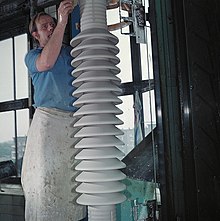
High voltage ceramic bushing during manufacture, before glazing (1977)
The electrical breakdown of an insulator due to excessive voltage can occur in one of two ways:
- A puncture arc is a breakdown and conduction of the material of the insulator, causing an electric arc through the interior of the insulator. The heat resulting from the arc usually damages the insulator irreparably. Puncture voltage is the voltage across the insulator (when installed in its normal manner) that causes a puncture arc.
- A flashover arc is a breakdown and conduction of the air around or along the surface of the insulator, causing an arc along the outside of the insulator. Insulators are usually designed to withstand flashover without damage. Flashover voltage is the voltage that causes a flash-over arc.
Most high voltage insulators are designed with a lower flashover voltage than puncture voltage, so they flash over before they puncture, to avoid damage.
Dirt, pollution, salt, and particularly water on the surface of a high voltage insulator can create a conductive path across it, causing leakage currents and flashovers. The flashover voltage can be reduced by more than 50% when the insulator is wet. High voltage insulators for outdoor use are shaped to maximise the length of the leakage path along the surface from one end to the other, called the creepage length, to minimise these leakage currents.[8] To accomplish this the surface is moulded into a series of corrugations or concentric disc shapes. These usually include one or more sheds; downward facing cup-shaped surfaces that act as umbrellas to ensure that the part of the surface leakage path under the ‘cup’ stays dry in wet weather. Minimum creepage distances are 20–25 mm/kV, but must be increased in high pollution or airborne sea-salt areas.
Types of insulators[edit]
These are the common classes of insulators:[citation needed]
- Pin insulator – As the name suggests, the pin type insulator is mounted on a pin on the cross-arm on the pole. There is a groove on the upper end of the insulator. The conductor passes through this groove and is tied to the insulator with annealed wire of the same material as the conductor. Pin type insulators are used for transmission and distribution of communications, and electric power at voltages up to 33 kV. Insulators made for operating voltages between 33 kV and 69 kV tend to be very bulky and have become uneconomical in recent years.
- Post insulator – A type of insulator in the 1930s that is more compact than traditional pin-type insulators and which has rapidly replaced many pin-type insulators on lines up to 69 kV and in some configurations, can be made for operation at up to 115 kV.
- Suspension insulator – For voltages greater than 33 kV, it is a usual practice to use suspension type insulators, consisting of a number of glass or porcelain discs connected in series by metal links in the form of a string. The conductor is suspended at the bottom end of this string while the top end is secured to the cross-arm of the tower. The number of disc units used depends on the voltage.
- Strain insulator – A dead end or anchor pole or tower is used where a straight section of line ends, or angles off in another direction. These poles must withstand the lateral (horizontal) tension of the long straight section of wire. To support this lateral load, strain insulators are used. For low voltage lines (less than 11 kV), shackle insulators are used as strain insulators. However, for high voltage transmission lines, strings of cap-and-pin (suspension) insulators are used, attached to the crossarm in a horizontal direction. When the tension load in lines is exceedingly high, such as at long river spans, two or more strings are used in parallel.
- Shackle insulator – In early days, the shackle insulators were used as strain insulators. But nowaday, they are frequently used for low voltage distribution lines. Such insulators can be used either in a horizontal position or in a vertical position. They can be directly fixed to the pole with a bolt or to the cross arm.
- Bushing – enables one or several conductors to pass through a partition such as a wall or a tank, and insulates the conductors from it.[9]
- Line post insulator
- Station post insulator
- Cut-out
Suspension insulators[edit]
| Line voltage (kV) |
Discs |
|---|---|
| 34.5 | 3 |
| 69 | 4 |
| 115 | 6 |
| 138 | 8 |
| 161 | 11 |
| 230 | 14 |
| 287 | 15 |
| 345 | 18 |
| 360 | 23 |
| 400 | 24 |
| 500 | 34 |
| 600 | 44 |
| 750 | 59 |
| 765 | 60 |
Pin-type insulators are unsuitable for voltages greater than about 69 kV line-to-line. Higher transmission voltages use suspension insulator strings, which can be made for any practical transmission voltage by adding insulator elements to the string.[11]
Higher voltage transmission lines usually use modular suspension insulator designs. The wires are suspended from a ‘string’ of identical disc-shaped insulators that attach to each other with metal clevis pin or ball and socket links. The advantage of this design is that insulator strings with different breakdown voltages, for use with different line voltages, can be constructed by using different numbers of the basic units. Also, if one of the insulator units in the string breaks, it can be replaced without discarding the entire string.
Each unit is constructed of a ceramic or glass disc with a metal cap and pin cemented to opposite sides. To make defective units obvious, glass units are designed so that an overvoltage causes a puncture arc through the glass instead of a flashover. The glass is heat-treated so it shatters, making the damaged unit visible. However the mechanical strength of the unit is unchanged, so the insulator string stays together.
Standard suspension disc insulator units are 25 centimetres (9.8 in) in diameter and 15 cm (6 in) long, can support a load of 80-120 kN (18-27 klbf), have a dry flashover voltage of about 72 kV, and are rated at an operating voltage of 10-12 kV.[12] However, the flashover voltage of a string is less than the sum of its component discs, because the electric field is not distributed evenly across the string but is strongest at the disc nearest to the conductor, which flashes over first. Metal grading rings are sometimes added around the disc at the high voltage end, to reduce the electric field across that disc and improve flashover voltage.
In very high voltage lines the insulator may be surrounded by corona rings.[13] These typically consist of toruses of aluminium (most commonly) or copper tubing attached to the line. They are designed to reduce the electric field at the point where the insulator is attached to the line, to prevent corona discharge, which results in power losses.
History[edit]
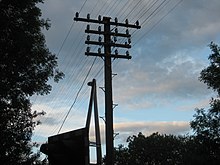
A recent photo of an open wire telegraph pole route with porcelain insulators. Quidenham, Norfolk, United Kingdom
The first electrical systems to make use of insulators were telegraph lines; direct attachment of wires to wooden poles was found to give very poor results, especially during damp weather.
The first glass insulators used in large quantities had an unthreaded pinhole. These pieces of glass were positioned on a tapered wooden pin, vertically extending upwards from the pole’s crossarm (commonly only two insulators to a pole and maybe one on top of the pole itself). Natural contraction and expansion of the wires tied to these “threadless insulators” resulted in insulators unseating from their pins, requiring manual reseating.
Amongst the first to produce ceramic insulators were companies in the United Kingdom, with Stiff and Doulton using stoneware from the mid-1840s, Joseph Bourne (later renamed Denby) producing them from around 1860 and Bullers from 1868. Utility patent number 48,906 was granted to Louis A. Cauvet on 25 July 1865 for a process to produce insulators with a threaded pinhole: pin-type insulators still have threaded pinholes.
The invention of suspension-type insulators made high-voltage power transmission possible. As transmission line voltages reached and passed 60,000 volts, the insulators required become very large and heavy, with insulators made for a safety margin of 88,000 volts being about the practical limit for manufacturing and installation. Suspension insulators, on the other hand, can be connected into strings as long as required for the line’s voltage.
A large variety of telephone, telegraph and power insulators have been made; some people collect them, both for their historic interest and for the aesthetic quality of many insulator designs and finishes. One collectors organisation is the US National Insulator Association, which has over 9,000 members.[14]
Insulation of antennas[edit]
Often a broadcasting radio antenna is built as a mast radiator, which means that the entire mast structure is energised with high voltage and must be insulated from the ground. Steatite mountings are used. They have to withstand not only the voltage of the mast radiator to ground, which can reach values up to 400 kV at some antennas, but also the weight of the mast construction and dynamic forces. Arcing horns and lightning arresters are necessary because lightning strikes to the mast are common.
Guy wires supporting antenna masts usually have strain insulators inserted in the cable run, to keep the high voltages on the antenna from short circuiting to ground or creating a shock hazard. Often guy cables have several insulators, placed to break up the cable into lengths that prevent unwanted electrical resonances in the guy. These insulators are usually ceramic and cylindrical or egg-shaped (see picture). This construction has the advantage that the ceramic is under compression rather than tension, so it can withstand greater load, and that if the insulator breaks, the cable ends are still linked.
These insulators also have to be equipped with overvoltage protection equipment. For the dimensions of the guy insulation, static charges on guys have to be considered. For high masts, these can be much higher than the voltage caused by the transmitter, requiring guys divided by insulators in multiple sections on the highest masts. In this case, guys which are grounded at the anchor basements via a coil – or if possible, directly – are the better choice.
Feedlines attaching antennas to radio equipment, particularly twin lead type, often must be kept at a distance from metal structures. The insulated supports used for this purpose are called standoff insulators.
Insulation in electrical apparatus[edit]

PVC-sheathed mineral insulated copper cable with 2 conducting cores.
The most important insulation material is air. A variety of solid, liquid, and gaseous insulators are also used in electrical apparatus. In smaller transformers, generators, and electric motors, insulation on the wire coils consists of up to four thin layers of polymer varnish film. Film insulated magnet wire permits a manufacturer to obtain the maximum number of turns within the available space. Windings that use thicker conductors are often wrapped with supplemental fiberglass insulating tape. Windings may also be impregnated with insulating varnishes to prevent electrical corona and reduce magnetically induced wire vibration. Large power transformer windings are still mostly insulated with paper, wood, varnish, and mineral oil; although these materials have been used for more than 100 years, they still provide a good balance of economy and adequate performance. Busbars and circuit breakers in switchgear may be insulated with glass-reinforced plastic insulation, treated to have low flame spread and to prevent tracking of current across the material.
In older apparatus made up to the early 1970s, boards made of compressed asbestos may be found; while this is an adequate insulator at power frequencies, handling or repairs to asbestos material can release dangerous fibers into the air and must be carried cautiously. Wire insulated with felted asbestos was used in high-temperature and rugged applications from the 1920s. Wire of this type was sold by General Electric under the trade name “Deltabeston.”[15]
Live-front switchboards up to the early part of the 20th century were made of slate or marble. Some high voltage equipment is designed to operate within a high pressure insulating gas such as sulfur hexafluoride. Insulation materials that perform well at power and low frequencies may be unsatisfactory at radio frequency, due to heating from excessive dielectric dissipation.
Electrical wires may be insulated with polyethylene, crosslinked polyethylene (either through electron beam processing or chemical crosslinking), PVC, Kapton, rubber-like polymers, oil impregnated paper, Teflon, silicone, or modified ethylene tetrafluoroethylene (ETFE). Larger power cables may use compressed inorganic powder, depending on the application.
Flexible insulating materials such as PVC (polyvinyl chloride) are used to insulate the circuit and prevent human contact with a ‘live’ wire – one having voltage of 600 volts or less. Alternative materials are likely to become increasingly used due to EU safety and environmental legislation making PVC less economic.
Class I and Class II insulation[edit]
All portable or hand-held electrical devices are insulated to protect their user from harmful shock.
Class I insulation requires that the metal body and other exposed metal parts of the device be connected to earth via a grounding wire that is earthed at the main service panel—but only needs basic insulation on the conductors. This equipment needs an extra pin on the power plug for the grounding connection.
Class II insulation means that the device is double insulated. This is used on some appliances such as electric shavers, hair dryers and portable power tools. Double insulation requires that the devices have both basic and supplementary insulation, each of which is sufficient to prevent electric shock. All internal electrically energized components are totally enclosed within an insulated body that prevents any contact with “live” parts. In the EU, double insulated appliances all are marked with a symbol of two squares, one inside the other.[16]

